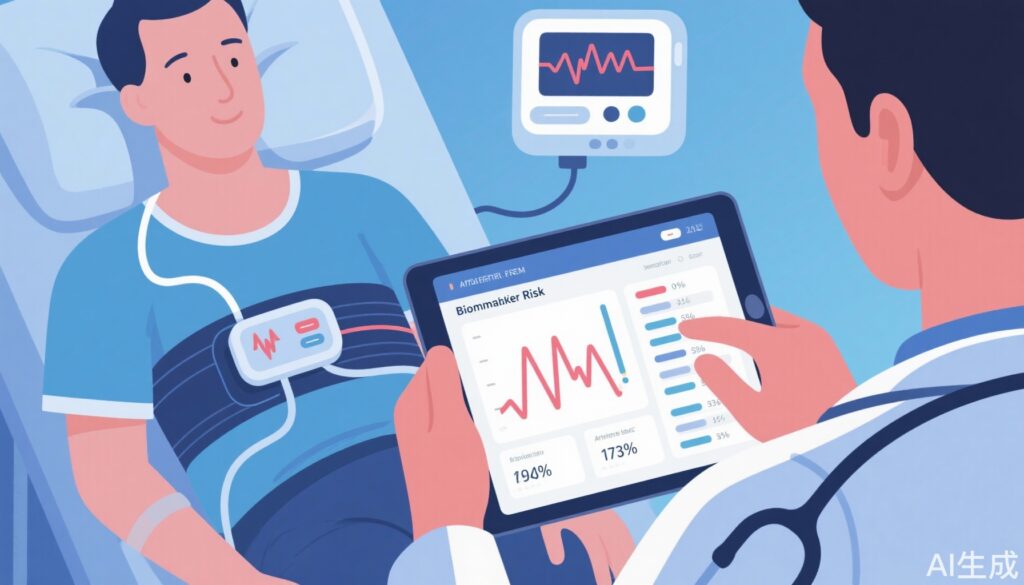Highlight
This multicenter, registry-based randomized controlled study evaluated the efficacy of biomarker-based ABC-AF risk scores in guiding personalized treatment for atrial fibrillation (AF). Despite tailoring anticoagulant strategies using individual stroke and bleeding risks, the biomarker-guided approach did not reduce stroke or death compared to standard guideline care. The study, terminated early due to safety concerns, highlights the challenges in translating precision medicine into improved clinical outcomes.
Study Background and Disease Burden
Atrial fibrillation (AF) is the most common arrhythmia worldwide and a major contributor to stroke morbidity and mortality. Stroke prevention through oral anticoagulation (OAC) is the cornerstone of AF management. However, balancing stroke risk against bleeding risk remains complex, necessitating reliable stratification tools. Traditional risk scores such as CHA2DS2-VASc guide anticoagulation decisions but have limitations in individual risk prediction. Biomarker-based scores like the ABC-AF (Age, Biomarkers, Clinical history in AF) risk score integrate laboratory markers with clinical variables, offering potentially more precise prediction of stroke and bleeding risk. Yet, prospective evidence for their impact on clinical decision-making and outcomes is scarce.
Study Design
This open-label, randomized controlled trial enrolled 3,933 adults with documented AF across multiple centers through registry platforms. Patients were randomized to an active intervention arm or control. In the active arm, investigators received individualized ABC-AF risk scores that estimated stroke and bleeding risks based on biomarkers and clinical factors. These scores served as decision support for tailoring anticoagulation therapy, including choice of direct oral anticoagulants (DOACs). In the control arm, management followed usual care per guidelines without biomarker guidance. The primary composite endpoint was stroke or death. Secondary endpoints included individual components plus major bleeding events and their composite outcome. The median follow-up was 2.6 years.
Key Findings
The population had a median age of 73.9 years, with 33.6% women and 51.3% paroxysmal AF. Most patients (85.7%) received oral anticoagulation after randomization. The active arm had higher OAC uptake (97.8%) compared to control (92.6%, p<0.0001), reflecting intensified management. However, enrollment was stopped prematurely due to safety concerns: notably, a trend toward higher mortality among patients with CHA2DS2-VASc scores ≥3 in the active arm, raising concern about potential harm and resulting underpowering for the primary endpoint.
Over follow-up, primary events (stroke or death) occurred at rates of 3.18 per 100 patient-years (PY) in the active arm vs. 2.67 per 100 PY in control (hazard ratio [HR] 1.19; 95% confidence interval [CI], 0.96–1.48; p=0.12). No statistically significant differences were observed for stroke alone (HR 1.18; 95% CI, 0.78–1.79; p=0.44), death (HR 1.21; 95% CI, 0.94–1.55; p=0.13), or major bleeding events (HR 1.08; 95% CI, 0.86–1.36; p=0.50). The composite of stroke, death, or major bleeding showed a non-significant trend favoring control (HR 1.14; 95% CI, 0.96–1.36; p=0.13). Importantly, outcomes were consistent across ABC-AF score subgroups (interaction p=0.98), suggesting no subgroup benefited from the biomarker-guided approach.
Expert Commentary
The trial represents the first large prospective effort to test biomarker-based risk stratification tools for personalized therapy in AF outside observational contexts. Despite strong prognostic foundations, the ABC-AF guided strategy did not translate into improved outcomes, highlighting several critical considerations.
First, intensified anticoagulation adherence in the active arm, although logical, may have paradoxically increased bleeding or other adverse events, underlining the risks of overtreatment. Second, early termination limited statistical power, possibly masking small but clinically relevant benefits. Third, risk scores, while predictive, may not capture complex patient-level factors that influence therapy response and events.
These findings are consistent with prior literature emphasizing the need for rigorous clinical validation of precision medicine tools. Current guidelines continue to recommend clinical risk scores like CHA2DS2-VASc and HAS-BLED while awaiting further evidence on biomarker integration. Future research should explore refinements including dynamic biomarker monitoring, integration with imaging, and patient-centered decision frameworks.
Conclusions
This registry-based randomized controlled study demonstrated that an ABC-AF biomarker-guided multidimensional anticoagulant strategy did not improve stroke or death outcomes compared to usual guideline-based care in patients with atrial fibrillation. The trial was prematurely stopped due to safety concerns, highlighting the complexities of translating biomarker-based risk scores into clinical benefit. The study underscores that novel precision medicine tools require robust prospective testing before routine clinical adoption. Meanwhile, guideline-recommended risk stratification and management remain paramount for optimal care of patients with AF.
References
1. Oldgren J, Hijazi Z, Arheden H, Björkenheim A, Frykman V, Janzon M, Ravn-Fischer A, Renlund H, Själander A, Åkerfeldt T, Wallentin L. Biomarker-based ABC-AF Risk Scores for Personalized Treatment to Reduce Stroke or Death in Atrial Fibrillation – a Registry-based Multicenter Randomized Controlled Study. Circulation. 2025 Aug 30. doi: 10.1161/CIRCULATIONAHA.125.076725. Epub ahead of print. PMID: 40884774.
2. Kirchhof P, Benussi S, Kotecha D, et al. 2016 ESC Guidelines for the management of atrial fibrillation developed in collaboration with EACTS: The Task Force for the Management of Atrial Fibrillation of the European Society of Cardiology (ESC). Eur Heart J. 2016;37(38):2893-2962.
3. Lip GYH, Banerjee A, Boriani G, et al. Atrial fibrillation. Nat Rev Dis Primers. 2016;2:16016.
4. Hijazi Z, Oldgren J, Siegbahn A, et al. Biomarkers in atrial fibrillation: a clinical review. Eur Heart J. 2013;34(12):843-849.



